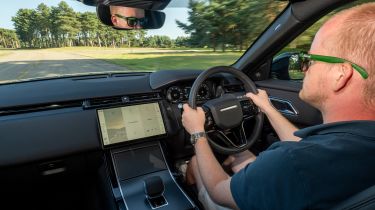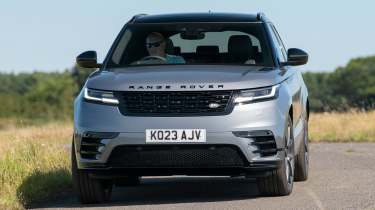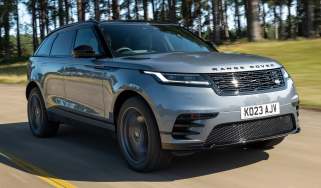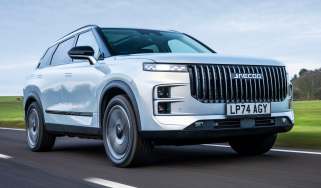Range Rover Velar review - Engines, drive & performance
The Range Rover Velar is comfortable and luxurious, with brawny engines ensuring performance isn’t lacking either
The Range Rover Velar is at a great advantage here, because it shares its fundamental mechanical architecture with the Jaguar F-Pace – one of the best-handling SUVs money can buy. However, it doesn't take long to conclude that the Velar is designed with a greater focus on comfort than driving dynamics.
Most Velar models come with conventional steel-spring suspension – as opposed to the more expensive air suspension – which does a good job of absorbing bumps, especially at low speed. But that doesn't lend the Velar a particularly agile feel. Where the F-Pace slices through corners, the Velar rolls a little more. It doesn’t inspire the confidence you feel in the Jag or its Porsche Macan rival. It’s still composed though, and grips well too, even on all-weather tyres.
If you push the Velar a bit harder, you can feel the electronic safeguards holding the heavy SUV on an even keel – the stability control applies the brakes to any wheel where things seem to be getting too chaotic, while the engine-management system can cut the power as appropriate, too. Although the sportier driving mode adds weight to the steering, it does little to make the Velar feel more nimble.
More reviews
In-depth reviews
Road tests
The picture is rather more encouraging if you treat the Velar as an exemplary high-speed cruiser; noise from the engine barely penetrates the car’s interior and a pervading sense of smoothness sets the tone – that’s thanks to the Active Road Noise Cancellation system, which is an intriguing hi-tech solution to reducing road roar. There’s precious little wind noise, either, and while that means the Velar’s large alloy wheels seem to throw up more road noise than they actually do, it’s an impressively quiet cruiser.
Air-suspension is a £1,200 cost option on most of the engine and trim combinations, but standard on some of the higher-end models. Fitting this makes things even smoother, while also improving the Velar’s off-road ability.
Range Rover Velar diesel engines
The Velar range starts with a 201bhp D200 2.0-litre diesel engine, which takes 7.8 seconds to go from 0-60mph. Upgrading to the 296bhp D300 3.0-litre diesel engine slashes that time to 6.1 seconds, which represents a level of performance more in keeping with a car of the Velar’s price. A strong 700Nm of torque and the slick-shifting eight-speed automatic gearbox means this version feels really quick from 30-70mph.
Petrol engines
There’s now just one petrol engine available with the regular Velar. While the 2.0-litre 247bhp four-cylinder unit badged P250 was available before, it’s been discontinued leaving the 3.0-litre straight-six P400. The P400 gets 395bhp and features mild-hybrid assistance – It will do 0-60mph in 5.2 seconds. In other markets, Land Rover offers a middling P340 petrol, though this is not currently available on the UK configurator.
Land Rover used to build a ballistic 542bhp Range Rover Velar SVAutobiography Dynamic with the V8 engine from a Jaguar F-Pace SVR, but it’s since been discontinued. It was incredibly quick (0-60mph takes 4.3 seconds) but it’s the soundtrack that puts the biggest smile on your face. Beware, however, you’ll soon be on first-name terms with your local petrol station employees – it’s incredibly thirsty.
Plug-in hybrid
The P400e powertrain is the Velar’s plug-in hybrid model and produces an overall power output of 398bhp. These models accelerate from 0-60mph in around 5.1 seconds and have official fuel consumption figures between 150mpg and 169mpg, depending on the trim level. It’s frugal if you’re able to plug it in frequently, but we’ve found economy plummets when you don’t, making it little more fuel-efficient than the regular petrol versions. It feels quick though, at least when the engine is working away. In EV mode alone the electric motors don’t have much power but combined they work well – if still not as effortlessly as the six-cylinder D300 diesel.














